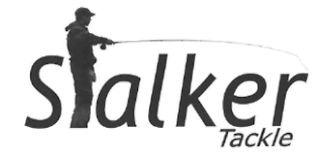 |
| Making short work of the sole defendant .... |
Folly argued that there was no double-identity infringement since the respective marks weren't identical: his was actually "Stalker Tackle" plus the T-shaped angler, while Fox's trade mark was really FOX STALKER because it used STALKER together with the prefix FOX. In any event, he said, "stalker" is a generic term, so Fox's mark was invalid in the first place. Finally, if all else failed, there was no infringement since his use of the word "stalker" was not an indication of origin, being purely descriptive, "stalking being an angling term for "mobile fishing".
This uncomfortably weak array of arguments might lead the reader to suspect that Folly was well named, unless he had rock-solid evidence on which to support his contentions (which he did not). The extent of his folly can be further gauged from the fact that he represented himself -- even though the judge encouraged him at the case management conference to get himself some legal representation. Any IP lawyer, receiving instructions from him on these facts, would probably have said something along the lines of "give up, come out quietly with your hands raised high above your head and say 'Don't shoot! I'm sorry, I won't do it again ...'" A lawyer's advice at that stage would surely be less expensive than the cost to him of contesting the incontestable.
As it was, Judge Birss QC was as kind and gentle to Folly as one could ever hope for, seeing as he was giving judgment for Fox. In his view:
- Fox didn't use the word STALKER only in tandem with the word FOX -- but it frankly didn't matter whether the company did or not since double-identity infringement under Article 9(1)(a) is measured with regard to the mark which is registered -- and that was the word STALKER alone.
- Folly used the word STALKER alone, and that word was plainly identical to Fox''s trade mark. However, Folly's device wasn't just the word "stalker" -- it was a sort of "stalker-plus" because it included a striking image of an angler with a rod, which was not identical to Fox's STALKER word mark. This didn't help Folly, though, since he used the word "stalker" as a badge of origin for products which he wasn't just describing but was selling. For example his website stated "Welcome to the Stalker website" and "We will be adding to our range..." and the "We" clearly referred back to "Stalker" and showed that, to someone viewing the site, "Stalker" referred to the entity from which the goods originated. No-one looking at Folly's website or eBay pages would think he was using the word in a descriptive sense. This was real Article 9(1)(a) infringement and there was no defence of honest descriptive use.
- As for 'likelihood-of-confusion' infringement, it had to be asked if Folly's use of his mark without the word 'Tackle' (the usual way he used it) gave rise to a likelihood of confusion. The average purchaser of fishing goods who was familiar with Fox's products would generally associate them with its FOX mark, but would also be aware that Fox's goods were often just marked STALKER. It's actually more difficult to spot a sign that's missing (e.g. where there's no FOX with the STALKER) than spotting the presence of one that's there. Even if a purchaser spotted the absence of the word FOX on Folly's goods, the impact of that revelation would not be enough to negate his natural assumption that Folly's goods came from the same source as the STALKER goods which he already knew about. Folly's attractive little device therefore created a likelihood of confusion.
- There was no evidence that Fox's STALKER mark was or had become a common name in the trade for angling kit in result of either Fox's acts or omissions, which would have given Folly an escape route under Article 51 of the Regulation. Nor could it be argued that STALKER was not inherently distinctive and thus vulnerable to an invalidity attack under Article 52.
Deceptive mark? Where a fox is a bear here
